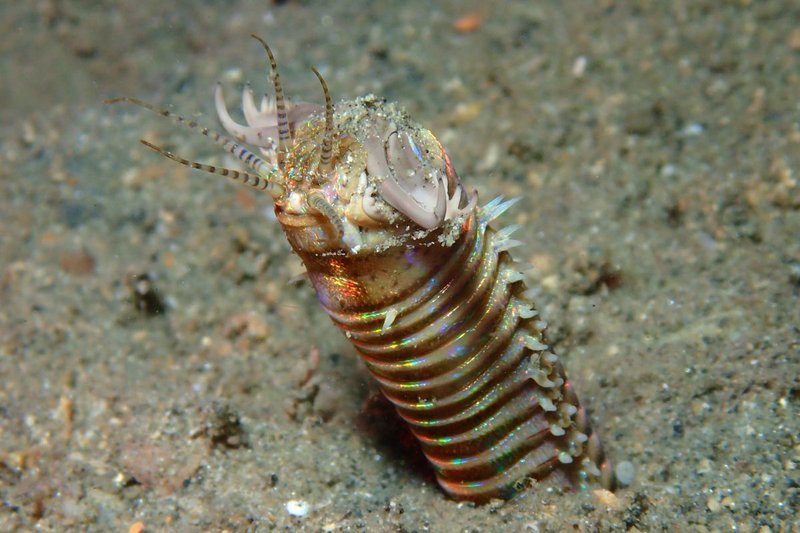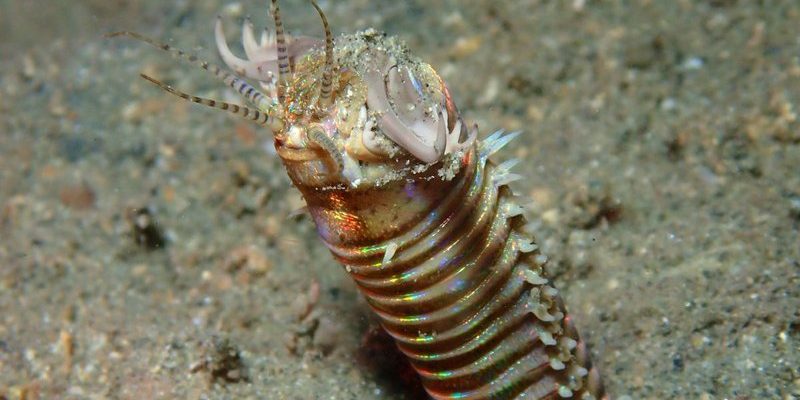
You might be wondering why Bobbit worms are becoming a popular choice for public displays. Well, it’s not just their striking appearance that draws visitors in. These worms can play a vital role in the ecosystem of a reef tank, helping to maintain balance and health. However, their unique characteristics can pose challenges, especially for aquarium staff. So, let’s dive deeper into understanding how to handle and display these intriguing creatures in public aquariums.
What Are Bobbit Worms?
Bobbit worms, scientifically known as *Eunice aphroditois*, are marine polychaete worms found in warm waters around the world, including the Caribbean and Indo-Pacific regions. They can grow quite large—up to 10 feet or more—making them one of the biggest worms in the ocean. Imagine a colorful ribbon dancing in the water, but with a purpose! These worms have strong jaws that can snap at prey, which allows them to thrive in various marine environments.
These worms create burrows in the seabed, often made of sand and organic materials, where they hide until prey comes too close. When it does, the Bobbit worm’s speed and stealth allow it to pounce, snatching up fish or crustaceans with lightning-fast reflexes. It’s a striking illustration of nature’s predatory strategies.
Why Display Bobbit Worms in Aquariums?
Exhibiting Bobbit worms can be a unique draw for public aquariums. Here’s the thing: they add an exotic touch and serve as a conversation starter among visitors. When people see these fascinating creatures, they often ask questions and want to learn more, increasing engagement and interest in marine life.
Furthermore, Bobbit worms contribute to the health of the aquarium environment. Their burrowing habits help aerate the substrate and promote the natural breakdown of waste. This means they can play a role in maintaining water quality—an essential factor for any aquarium.
However, displaying these creatures requires understanding and preparation. Care must be taken to provide the right conditions for their habitat, ensuring they remain healthy and comfortable.
Creating the Right Habitat
Setting up a suitable environment for Bobbit worms is crucial. They thrive in warm, salty waters, mimicking their natural settings. A well-balanced reef tank is ideal, as it supports the diverse life forms that can coexist beautifully with Bobbit worms.
Here’s how to create the perfect habitat:
- Temperature: Maintain a water temperature between 75°F and 85°F (24°C to 29°C). These warm conditions mimic their tropical origins.
- Salinity: Aim for a salinity level around 1.020 to 1.025. A hydrometer can help you achieve accurate readings.
- Substrate: Use fine sand or crushed coral to allow the worms to dig and create their burrows.
- Water Quality: Regularly monitor ammonia, nitrate, and nitrite levels to ensure a healthy environment.
You might be wondering what happens if the habitat conditions aren’t right. Poor water quality or inappropriate temperatures can stress the worms, potentially leading to health issues or even death. Keeping a close eye on these factors helps ensure a thriving display.
Handling Bobbit Worms Safely
Handling Bobbit worms requires careful consideration. Their sharp jaws can deliver a painful bite if provoked. Here are some tips to handle them safely:
- Use Protective Gear: Always wear gloves when working near or handling these worms, as their bites can be painful.
- Minimal Disturbance: Try to avoid disturbing their burrows unnecessarily. If you need to move them, do so gently and with proper tools.
- Educate Staff: Ensure that aquarium staff are trained on the proper techniques for dealing with Bobbit worms to prevent accidents.
Handling these creatures with respect not only protects you but also promotes their health and well-being. Think of it as a partnership where both humans and worms can thrive.
Feeding Bobbit Worms in Captivity
Feeding Bobbit worms can feel like a bit of a balancing act. Since they are carnivorous predators, they usually feast on small fish, shrimp, or other invertebrates. It’s essential to strike the right balance so they stay healthy without overfeeding.
Here’s what you need to know:
- Diet Variety: Provide a varied diet to mimic their natural feeding habits. This could include pieces of shrimp, fish, or specially formulated marine pellets.
- Feeding Schedule: Feed them small portions once or twice a week. Overfeeding can lead to water quality issues and health problems.
- Monitor Activity: Watch how they respond to feeding. If they’re actively hunting and eating, you’re likely on the right track!
When you take the time to feed them properly, you’re not just maintaining their health; you’re also contributing to the overall ecosystem of the aquarium.
Common Challenges in Displaying Bobbit Worms
While Bobbit worms can be a star attraction, they come with their fair share of challenges. For instance, their predatory nature can lead to conflicts with other tank occupants, especially smaller fish or invertebrates that might be seen as prey.
Some common challenges include:
- Compatibility Issues: Ensure that the other species in the tank can coexist without being threatened. Research which tank mates are suitable.
- Escape Artists: These worms can sometimes attempt to escape if they feel stressed. Secure the tank and its substrate to avoid losing any critters.
- Health Monitoring: Keep an eye out for signs of stress or health issues, like unusual burrowing habits or color changes.
Addressing these challenges head-on can help maintain a peaceful and healthy aquarium environment.
Best Practices for Displaying Bobbit Worms
To make the display of Bobbit worms successful and engaging, public aquariums can implement some best practices. Here are a few ideas:
- Interactive Displays: Install touchscreens or signage that educates visitors about Bobbit worms, their habitat, and behavior.
- Regular Feeding Demonstrations: Schedule feeding times during which visitors can watch the worms in action, catching prey and showing off their unique hunting skills.
- Group Housing: Consider showcasing how Bobbit worms interact with other marine life by having a community tank that promotes healthy biodiversity.
These practices not only educate the public but also enhance their experience, making it more memorable.
In closing, displaying **Bobbit worms** in public aquariums offers a unique opportunity to showcase the wonders of marine life. By understanding their needs, handling them carefully, and creating a suitable habitat, aquarists can effectively integrate these intriguing creatures into vibrant aquatic displays. So the next time you visit an aquarium and spot one of these long, colorful worms, you’ll appreciate not just its beauty but also the effort it takes to create and maintain its home.

